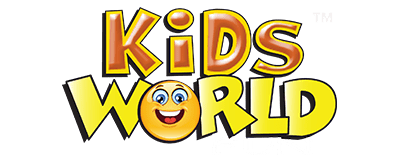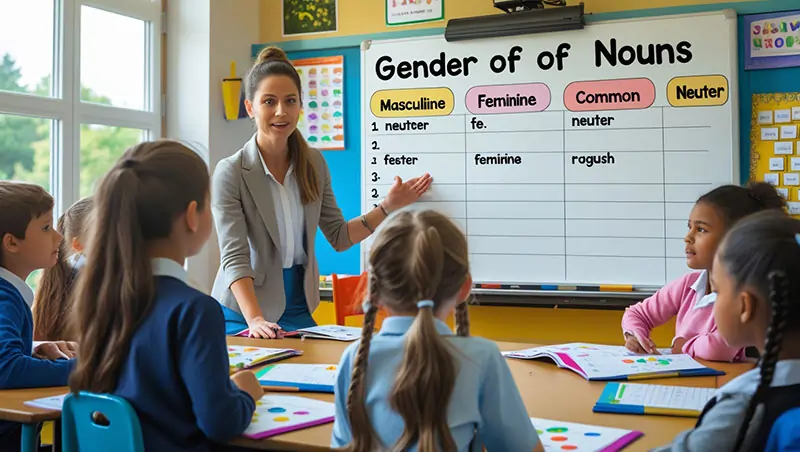Discovering the World Around Us: Fun Preschool Science Activities
Introduction to Science for Preschoolers
Science is not restricted to labs. It’s taking place in your living room at the moment. Your child just blew that bubble? science. The rainbow they saw following the rain from yesterday? science. What about the sandcastle that keeps falling apart? Whether they are aware of it or not, science is also teaching students about structural integrity.
Young children are born scientists. “What happens if I drop this?” is an experiment they do all the time. “Why does ice feel cold?” “Can I stack these blocks higher?” They are merely attempting to understand the world around them by tinkering with objects, which is the most efficient approach available. They are not attempting to be scientists.
Science teaching at this age is not about formulas or memorization. The goal is to pique their interest. Allow children to handle objects, smell them, combine things (in moderation), and ask endless “why” questions. This is how three-year-olds actually learn.
It was previously believed that children are natural scientists because they are curious, experiment, and observe. That person was entirely correct. It is not your responsibility to instill curiosity in them. They are already. It’s your responsibility to avoid unintentionally stifling that curiosity by making learning seem like labor.
The Importance of Early Curiosity
Not only is curiosity endearing, it is the cornerstone of all scientific thought. When children are encouraged to experiment and solve problems, they gain confidence, perseverance, and problem-solving abilities that will benefit them long after preschool.
As children grow, their curiosity develops as follows:
| Age | Type of Curiosity | Learning Outcome | Example Activity |
| 2–3 yrs | Sensory Curiosity | Learns through touch and taste | Water play, sand scooping |
| 3–4 yrs | Exploratory Curiosity | Begins to question “why” | Mixing colors |
| 4–5 yrs | Logical Curiosity | Starts predicting outcomes | Planting a seed and observing growth |
Early encouragement of this interest fosters a lifelong passion of solving problems in addition to preparing them for school. And truthfully? It’s more enjoyable to be around curious children. Rather than being bored by the world, they are actively involved in it.
Science in Daily Life: Colors, Textures, and Senses
Expensive equipment and lab coats are not necessary for science. It is already ingrained in daily existence. By simply investigating everyday household items, preschoolers can learn about states of matter, color mixing, and textures.
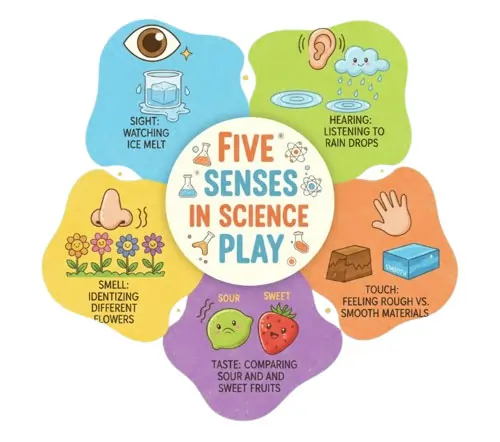
Children may grasp abstract ideas like change, reaction, and balance in concrete ways through these daily investigations. Instead of acquiring vocabulary, they are actually experiencing the occurrences that the words describe.
Easy Tests With Common Household Objects
A set of chemistry is not required. The most fascinating preschool science is done with items you already have in your cupboard or under your kitchen sink.
Simple Science Activities for Preschoolers
| Experiment | Materials | Concept | Observation |
| Rainbow Milk | Milk, dish soap, food coloring | Surface tension | Colors swirl and move when soap is added |
| Volcano Eruption | Baking soda, vinegar, food color | Chemical reaction | Bubbles form as gases release |
| Magic Balloon | Balloon, bottle, vinegar, baking soda | Gas expansion | Balloon inflates without blowing |
| Floating Egg | Salt water and egg | Density | Egg floats in salty water but sinks in plain water |
| Color Walking | Water, tissue paper, colored dyes | Capillary action | Colors travel and mix in the paper |
🧠 Pro Tip:
Make every experiment more than a demonstration; make it an inquiry. Prior to beginning, inquire: –
- What do you think will happen?
- Why did the colors move like that?
- What changed after we added the soap?
These are thought-provoking questions, not examinations. Are children learning to make predictions and relate cause to effect? That is an example of true scientific thought in action.
The Function of Questioning and Observation
The foundation of all science is observation. The problem with preschoolers is that they are excellent observers by nature. They pick up on little information that adults ignore. That ant with the crumb? Your child has spent five minutes watching it. Was it dinosaur-shaped cloud? They saw it right away.
It’s your responsibility to support and validate their innate ability to observe.
Promote the use of descriptive language by asking, “Is it hot or cold?” “Does it feel rough or smooth?” “Is it heavy or light?” Observations are more useful when they are specific.

| Skill | Example Activity | Question to Ask |
| Comparing | “Which object sinks faster?” | “Why do you think that happened?” |
| Predicting | “Will the plant grow faster in the sun?” | “What makes you think so?” |
| Recording | Drawing daily changes in a plant | “What did you notice today?” |
Tip for Parents: Get your child a little notepad and refer to it as their “science journal.” Let children illustrate their findings with drawings or photos; they don’t have to write. Their satisfaction in their scientific work is bolstered by a visual record of their observations.
Captivating Worksheets and Learning Through Pictures
Young children learn best visually. For a period. Text-heavy explanations are pointless because they are not yet able to read. To make concepts understandable, use sorting games, flashcards, and worksheets with illustrations.
Visual Learning Tool Examples:
- Matching Worksheets: Match animals to their environments, such as camels to the desert or penguins to ice.
- Sorting Charts: Use images to sort living versus non-living objects.
- Observation Sheets: Instead of writing about an experiment, draw what you observed.
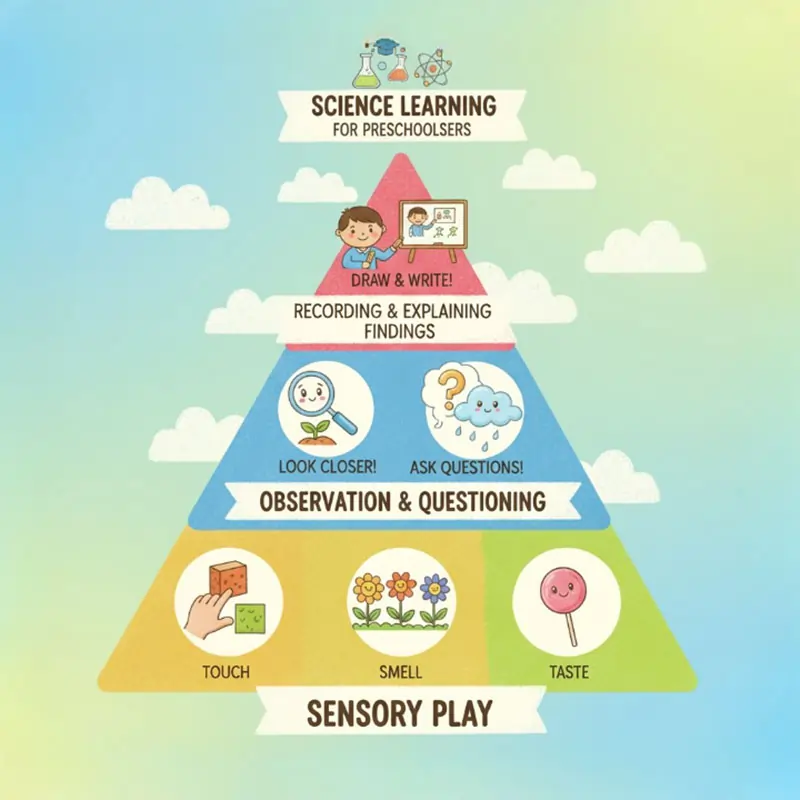
Even children who are not yet able to read can understand science. Thanks to these visual aids. For this age group, visual aids combined with practical experience equal real learning.
Parental Guidance and Safety Tips
At-home science activities should be both enjoyable and secure. Parents must strike a delicate balance between permitting exploration and averting catastrophes.
✅Preschool Science Safety Checklist
| Safety Rule | Why It Matters |
| Always supervise experiments | Prevents accidents or ingestion |
| Use non-toxic, household materials | Keeps learning safe and worry-free |
| Avoid heat or sharp objects | Suitable for small hands |
| Explain each step clearly | Builds understanding and confidence |
| Encourage cleanup after experiments | Teaches responsibility |
💡 Parenting Insight:
Refrain from providing all the answers at once. Ask your child what they think before you answer the question, “Why does ice melt?” After that, assist them in using observation to find the solution. Learning sticks better when children discover the answers on their own than when they are simply given them.
Inspiring Science-Based Activities for the Classroom or Home
Quick science, art, and play activities that are ideal for preschoolers with short attention spans:
- Color Mix Painting: Blend primary colors to produce new ones; it’s always entertaining to see purple form from red and blue.
- Grow Your Own Bean Plant: Track the slow yet fruitful development of roots and leaves
- Shadow Tracing: Discover the position of the sun and light by following shadows at various times to observe their movement.
- Sink or Float Game: Test various items in water; anticipation before testing heightens the fun
- Bubble Race: Blow bubbles across paper to learn about motion and air—physics masquerading as sheer fun.
These exercises improve motor skills, creativity, and—if done in groups—teamwork while encouraging practical exploration. They are also far more interesting than worksheets.
Advice for Caregivers and Teachers
Without going over budget, teachers can turn every available space in a preschool into a little science lab:
- Nature Walks: Bring children outdoors to gather flowers, leaves, and stones, then come inside to sort, compare, and talk about what you’ve found.
- STEM Corners: Build experiments with building blocks to determine which tower is the tallest. Why?
- Discovery Stations: Changing tables with sand exploration, water play, and magnet studies—keeps things interesting
- Science Storytime: Read children’s favorite picture books that include science into their storylines, such as Ada Twist, Scientist or The Very Hungry Caterpillar.
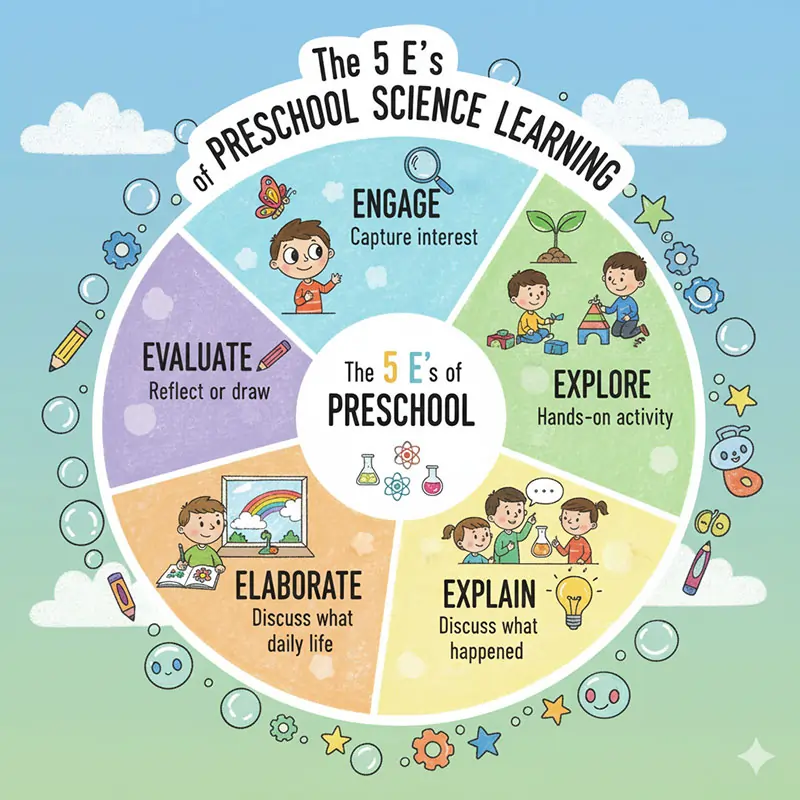
| Step | Description | Example |
| Engage | Capture interest | Show a colorful reaction |
| Explore | Hands-on activity | Play with magnets |
| Explain | Discuss what happened | Ask “Why?” |
| Elaborate | Connect to daily life | “Where do we see this at home?” |
| Evaluate | Reflect or draw | “What did we learn today?” |
This cycle turns haphazard play into purposeful, organized investigation. Even with deliberate learning incorporated, it’s still enjoyable.
❓ FAQs Regarding Science Activities in Preschool
Q1: When should children begin studying science?
Children begin to instinctively observe and question everything around the age of three, which is ideal for basic experiments and sensory play. It’s okay to go earlier; just change the difficulty.
Q2: Do I require specialized gear?
Not at all. The majority of preschool science projects involve commonplace supplies like food coloring, vinegar, baking soda, paper, and water. You most likely already have everything you need in your bathroom and kitchen.
Q3: How can I establish consistency in my learning?
Include science in your everyday activities. During walks, ask yourself, “Why do leaves change color?” “What happens when we mix milk and chocolate?” during meals. When taking a bath: “Why do toys float?” Science is not an event but a habit.
Q4: Can children safely participate in science activities?
Yes, provided non-toxic products are used and supervision is provided. Always do your own preview of experiments first. The rule is simple: don’t use it if you wouldn’t want them to drink it.
Q5: How can I maintain interest for various students?
Use a variety of methods: give kinesthetic learners hands-on activities, songs for auditory learners, and pictures for visual learners. Variety guarantees that everyone can relate in some way.
Final Thought: Integrating Science into Daily Pleasures
Learning complicated theories and retaining information are not the goals of preschool science. It’s about finding beauty in everyday objects. observing the growth of seeds. blending hues and exclaiming when new hues emerge. investigating the differences between floating and sinking objects.
Children learn to ask questions, pay close attention, and think creatively about the world through science at this age. These abilities are far more important than learning words that they will forget by kindergarten.
How can young scientists be nurtured most effectively? Make studying enjoyable. Even when it’s inconvenient, foster curiosity. Allow children to be messy—not just pretend to be messy. Honor their “Eureka!” moments, no of how minor they may appear to an adult. The truth is that when a three-year-old discovers purple and mixes colors, it’s not just play. They are taught that discovery comes from experimentation. Answers are the reward for that curiosity. that there are many amazing things in the world that are just waiting to be discovered.
